The Yokai Files – Tanuki – The myth and the reality
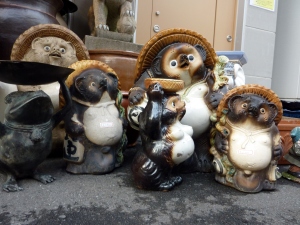 These ceramic Tanukis (Racoon Dogs), often seen outside Japanese cafes and bars thanks to some odd word association, are probably the most recognised images of these creatures.
These ceramic Tanukis (Racoon Dogs), often seen outside Japanese cafes and bars thanks to some odd word association, are probably the most recognised images of these creatures.
Don’t worry I’ll explain the word association later!
However, in Japan there is a rich folklaw tradition built up around the image of the Tanuki which means he pops up in some unusual places and surprising contexts.
I managed to see my second real life tanuki about a week ago, the first had been spotted in the headlights of our car scurrying to safety, this one however was right out in the open. Separated from us by a river he really didn’t seem bothered that we’d stopped our bikes and were watching him. Having heard so many of the myths surrounding then I was surprised to see the reality was so unremarkable, though I don’t think this was the most healthy specimen.
In the stories Tanuki are the eternal pranksters with magical abilities similar to faerie glamour, enabling them to pass off leaves and pebbles as notes and coins to trick unsuspecting humans.
Tanuki’s can also shape shift by putting a leaf on their head and would often take human form. Tanukis are traditionally fond of eating and drinking, and many of their tricks, such as kidnapping brides and impersonating them to attend a wedding feast, are simply to get good food and drink (and could be one of the reasons they are so frequently seen in front of eating and drinking establishments to this day).
These stories have led to a rather morbid trend in taxidermy however. A couple of times now I’ve stumbled across Tanuki stuffed and preserved in human poses as a literal interpretation of these stories. So here are a pilgrim Tanuki found at Fushimi Jinjya and a golfer Tanuki for sale in a second hand shop.
 Tanki’s shape shifting isn’t limited simply to human form, in one famous folk story ‘Bunbuku Chagama’ a Tanuki father transforms himself into a Japanese style teakettle which his wife sells to an antiques dealer to make money for his family.
Tanki’s shape shifting isn’t limited simply to human form, in one famous folk story ‘Bunbuku Chagama’ a Tanuki father transforms himself into a Japanese style teakettle which his wife sells to an antiques dealer to make money for his family.
Despite all this deceit Tanukis aren’t seem as being really bad, simply mischievous and life loving. When they do come into conflict with humans it can be seen as an ecological warning, just as real tanukis (like western raccoons and urban foxes) are forced into contact wth humans due to the destruction of their habitat so fictional Tanukis and forced into closer and closer proximity with humans too – but they can use all their trickery to fight back.
The 1994 Ghibli movie ‘PomPoko’ takes this idea as it’s basis showing the balance between man and nature through the plight of a group of Tanuki whose habitat is under threat by new construction.
 The movie shows the Racoon dogs variously as real tanuki, anthropomorphic creatures and full cartoon Tanuki at various times blending the reality and myth. So as the Tanuki use their tricks and magic to try and scare away the humans we are always reminded of the real animals they represent and our equally real responsibility to consider the natural balance around us.
The movie shows the Racoon dogs variously as real tanuki, anthropomorphic creatures and full cartoon Tanuki at various times blending the reality and myth. So as the Tanuki use their tricks and magic to try and scare away the humans we are always reminded of the real animals they represent and our equally real responsibility to consider the natural balance around us.
Whilst Pompoko is far from being my favorite Ghibli movie it is still interesting. It features several other yokai as well as the Tanukis themselves, and all of the classic Tanuki tricks are present and correct too. Including one I haven’t mentioned yet.
Take a look at these shots from the movie of some Tanuki parachuting.


Yes, those are testicle parachutes!
Magical expanding, multi-purpose testicles is another reoccurring theme in Tanuki folklaw. As early as the 1840, Ukiyo-e woodblock print master, Utagawa Kuniyoshi, made an interesting series of Tanuki prints showing them putting their magical testicles to use. Here’s a couple of examples, weight training and clubbing a catfish to death.


(There’s a fuller gallery of these over at Pink Tentacle)
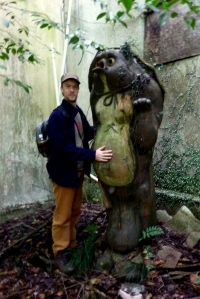 All of which brings us rather neatly back to the ceramic Tanukis from the top of this page. Even they have rather spectacular testes (as shown by this example that we found on a recent haikyo trip) and this is why they are so often seen outside restaurants, bars and in this case an old hotel.
All of which brings us rather neatly back to the ceramic Tanukis from the top of this page. Even they have rather spectacular testes (as shown by this example that we found on a recent haikyo trip) and this is why they are so often seen outside restaurants, bars and in this case an old hotel.
Ok it’s time to explain that word play. The japanese word for testicles is ‘kintama’ which can be broken into two smaller words ‘kin’ meaning ‘gold’ and ‘tama’ meaning ‘balls’ – literally golden balls.
So not only do they love good food and drink, but those big balls symbolise wealth and prosperity too.
For more information on Tanukis, and many other Yokai, I recommend picking up ‘Yokai Attack’ a fun and easy to read guide to Japan’s monsters, spirits and creatures.

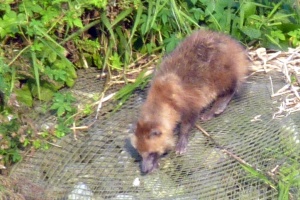
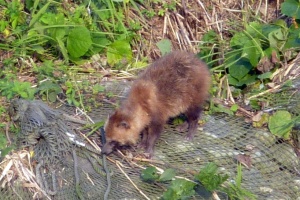
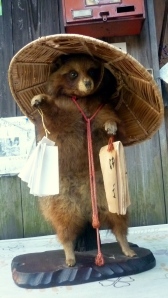

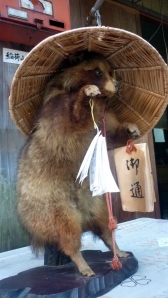
I love the woodblock prints…didn’t know about the Ghibli movie so many thanks for that!
November 17, 2010 at 7:36 pm
Thanks! I’ll actually be doing a second Tanuki post soon as I remembered I also have pictures of a small hidden Tanuki shrine in Kyoto and I didn’t post the cool childrens rhyme about Tanuki either.
I’ll be vistiting Shigaraki, where they make most of the ceramic Tanuki, this weekend and I’ll make another post after that.
November 17, 2010 at 11:00 pm
I’ll look forward to it!
November 24, 2010 at 6:40 pm
Tanukis and their balls are awesome. Don’t forget Tanooki (sic) Mario from Super Mario 3!
June 14, 2011 at 3:45 pm
do youkai really exist??
September 28, 2011 at 12:07 pm
Well Tanuki certainly exist – whether they can do magic or not as the stories say is another question.
However, I personally think the more ‘impossible’ things you allow yourself to be open minded about, the more interesting the world seems 🙂
October 4, 2011 at 10:09 am
We saw a Tanuki in someone’s garden and would love to have one. I have searched the net but could only find a 4″ desktop. Any suggestions where we could buy one?
Thanks.
May 7, 2012 at 10:36 pm
The biggest Tanuki making town in Japan is Shigaraki in Shiga Ken – well worth a visit, and many Tanuki to buy. Outside Japan I have no idea where you’d buy one – sorry!
September 15, 2012 at 8:10 am
We saw one of these in someone’s garden and would love to have one. I have searched the net and can’t find them (except a 4″ desktop). Any suggestions where we might be able to purchase them?
May 7, 2012 at 10:37 pm
Hi, I too am a fan of Tanukis, I will be visiting Japan at the end of March, do you know any place, like a park, wher i could see real live tanukis; I know there are som in Sensui Island, in front of Tomo-no-ura, but I missed them
January 26, 2013 at 6:55 pm